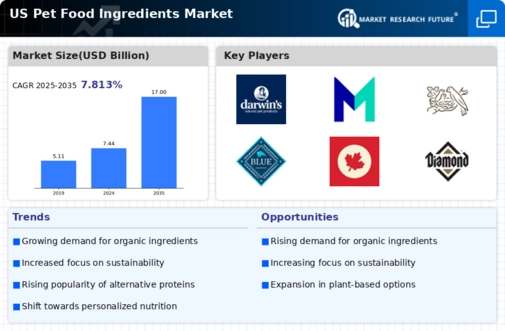The pet food-ingredients market exhibits a dynamic competitive landscape characterized by innovation, sustainability, and strategic partnerships. Key players such as Nestle Purina PetCare (US), Mars Petcare (US), and Hill's Pet Nutrition (US) are at the forefront, each adopting distinct strategies to enhance their market positioning. Nestle Purina PetCare (US) emphasizes product innovation, focusing on premium ingredients and health-oriented formulations, which aligns with the growing consumer demand for high-quality pet nutrition. Mars Petcare (US), on the other hand, appears to prioritize sustainability initiatives, aiming to reduce its carbon footprint and enhance supply chain transparency. Hill's Pet Nutrition (US) is leveraging scientific research to develop specialized diets, catering to specific health needs of pets, thus reinforcing its reputation as a leader in veterinary nutrition. Collectively, these strategies not only shape the competitive environment but also drive growth in the market, as companies adapt to evolving consumer preferences.
In terms of business tactics, companies are increasingly localizing manufacturing to enhance supply chain efficiency and reduce costs. This approach allows for quicker response times to market demands and fosters a more resilient supply chain. The market structure is moderately fragmented, with several key players holding substantial market shares, yet numerous smaller companies also contribute to the competitive dynamics. The collective influence of these major players, alongside emerging brands, creates a vibrant ecosystem where innovation and quality are paramount.
In October 2025, Nestle Purina PetCare (US) announced a partnership with a leading agricultural technology firm to develop sustainable sourcing practices for its ingredients. This strategic move is likely to enhance the company's commitment to sustainability while ensuring a reliable supply of high-quality ingredients. By integrating advanced agricultural practices, Nestle Purina PetCare (US) may not only improve its operational efficiency but also appeal to environmentally conscious consumers, thereby strengthening its market position.
In September 2025, Mars Petcare (US) launched a new line of plant-based pet food products, reflecting a growing trend towards vegetarian and vegan options in pet nutrition. This initiative is significant as it aligns with consumer preferences for sustainable and ethical food choices, potentially capturing a new segment of the market. By diversifying its product offerings, Mars Petcare (US) could enhance its competitive edge and respond to the increasing demand for alternative protein sources in pet food.
In August 2025, Hill's Pet Nutrition (US) unveiled a new research initiative aimed at developing personalized nutrition plans for pets based on genetic testing. This innovative approach is indicative of a broader trend towards customization in pet food, allowing for tailored dietary solutions that meet individual health needs. By investing in cutting-edge research, Hill's Pet Nutrition (US) is likely to solidify its leadership in the veterinary nutrition space and attract pet owners seeking specialized care for their animals.
As of November 2025, the competitive trends in the pet food-ingredients market are increasingly defined by digitalization, sustainability, and the integration of artificial intelligence in product development. Strategic alliances among companies are shaping the landscape, fostering innovation and enhancing supply chain reliability. The shift from price-based competition to a focus on innovation and technology is evident, as companies strive to differentiate themselves through quality and sustainability. Looking ahead, it appears that competitive differentiation will increasingly hinge on the ability to innovate and adapt to consumer demands, positioning companies for sustained growth in a rapidly evolving market.




















Leave a Comment